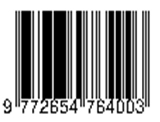PENGGUNAAN MEMBRAN POLY(LACTIC-CO-GLYCOLIC) ACID (PLGA) YANG DIPERKUAT OLEH NANOSELULOSA UNTUK PROSEDUR GUIDED BONE REGENERATION (GBR)
Abstract
Keywords
Full Text:
PDF (Bahasa Indonesia)References
Liu J, Kerns DG. Mechanisms of Guided Bone Regeneration: A Review. Open Dent J. 2014;8(1):56–65.
Rakhmatia YD, Ayukawa Y, Furuhashi A, Koyano K. Current barrier membranes: Titanium mesh and other membranes for guided bone regeneration in dental applications. J Prosthodont Res. 2013;57(1):3–14.
Caballe´-Serrano J, Munar-Frau A, Ortiz-Puigpelat O, Soto-Penaloza D, Pen˜arrocha M, Herna´ndez-Alfaro F. On the search of the ideal barrier membrane for guided bone regeneration. J Clin Exp Dent. 2018;10(5):e477–83.
Aprile P, Letourneur D, Simon-Yarza T. Membranes for Guided Bone Regeneration: A Road from Bench to Bedside. Adv Healthc Mater. 2020;9:1-24.
Lanao RPF, Jonker AM, Wolke JGC, Jansen JA, Van Hest JCM, Leeuwenburgh SCG. Physicochemical properties and applications of poly(lactic-co-glycolic acid) for use in bone regeneration. Tissue Eng - Part B Rev. 2013;19(4):380–90.
Lee SW, Kim SG. Membranes for the Guided Bone Regeneration. Maxillofac Plast Reconstr Surg. 2014 Nov 30;36(6):239–46.
Gentile P, Chiono V, Carmagnola I, Hatton P V. An overview of poly(lactic-co-glycolic) Acid (PLGA)-based biomaterials for bone tissue engineering. Int J Mol Sci. 2014;15(3):3640–59.
Kawasaki T, Ohba S, Nakatani Y, Asahina I. Clinical study of guided bone regeneration with resorbable polylactide-co-glycolide acid membrane. Odontology [Internet]. 2018;106(3):334–9.
Furuhashi A, Rakhmatia YD, Ayukawa Y, Koyano K. Titanium membrane layered between fluvastatin-loaded poly (lactic-co-glycolic) acid for guided bone regeneration. Regen Biomater. 2022;9:1-11.
Kumar A, Han SS. Efficacy of bacterial nanocellulose in hard tissue regeneration: A review. Materials. 2021;14:1-28.
Bacakova L, Pajorova J, Tomkova M, Matejka R, Broz A, Stepanovska J, et al. Applications of nanocellulose/nanocarbon composites: Focus on biotechnology and medicine. Nanomaterials. 2020;10(2):1–32.
Khan S, Siddique R, Huanfei D, Shereen MA, Nabi G, Bai Q, et al. Perspective Applications and Associated Challenges of Using Nanocellulose in Treating Bone-Related Diseases. Front Bioeng Biotechnol. 2021;9:1–19.
Nicu R, Ciolacu F, Ciolacu DE. Advanced functional materials based on nanocellulose for pharmaceutical/medical applications. Pharmaceutics. 2021;13(8).
Saska S, Teixeira LN, Tambasco De Oliveira P, Minarelli Gaspar AM, Lima Ribeiro SJ. Bacterial cellulose-collagen nanocomposite for bone tissue engineering. J. Mater. Chem. 2012;22:22102–22112.
Lee SH, An SJ, Lim YM, Huh JB. The Efficacy of Electron Beam Irradiated Bacterial Cellulose Membranes as Compared with Collagen Membranes on Guided Bone Regeneration in Peri-Implant Bone Defects. Materials (Basel). 2017;10(9):1018.
Zhang H, Wang J, Wang K, Xu L. A bilayered PLGA/multiwall carbon nanotubes/bacterial cellulose composite membrane for tissue regeneration of maxillary canine periodontal bone defects. Mater Lett. 2018;212:118–21.
Mo Y, Guo R, Liu J, Lan Y, Zhang Y, Xue W, et al. Preparation and properties of PLGA nanofiber membranes reinforced with cellulose nanocrystals. Colloids Surfaces B Biointerfaces. 2015;132:177–84.
Yang Z, Li X, Si J, Cui Z, Peng K. Morphological, Mechanical and Thermal Properties of Poly(lactic acid) (PLA)/Cellulose Nanofibrils (CNF) Composites Nanofiber for Tissue Engineering. J Wuhan Univ Technol Mater Sci Ed. 2019;34(1):207–15.
Zheng Z, Liu Y, Huang W, Mo Y, Lan Y, Guo R, et al. Neurotensin-loaded PLGA/CNC composite nanofiber membranes accelerate diabetic wound healing. Artif Cells, Nanomedicine Biotechnol. 2018;46:493–501.
Hoornaert A, D’Arros C, Heymann MF, Layrolle P. Biocompatibility, resorption and biofunctionality of a new synthetic biodegradable membrane for guided bone regeneration. Biomed Mater. 2016;11(4):1-12.
Gupta S, Gopalkrishna P, Nayak UY, Ginjupalli K, Hrishi TS, Chandrashekar C, et al. Simvastatin in polymer bioscaffold for bone regeneration. An in vitro and in vivo analysis. Stomatologija. 2021;23(4):114–20.
Wei YW, Sayed SM, Zhu WW, Xu KF, Wu FG, Xu J, et al. Antibacterial and Fluorescence Staining Properties of an Innovative GTR Membrane Containing 45S5BGs and AIE Molecules In Vitro. Nanomaterials. 2022;12(4).
Higuchi J, Fortunato G, Woz´niak B, Chodara A, Domaschke S, Męczyn´ska-Wielgosz S, et al. Polymer membranes sonocoated and electrosprayed with nano-hydroxyapatite for periodontal tissues regeneration. Nanomaterials. 2019;9(11).
Queiro´s EC, Pinheiro SP, Pereira JE, Prada J, Pires I, Dourado F, et al. Hemostatic Dressings Made of Oxidized Bacterial Nanocellulose Membranes. Polysaccharides. 2021;2(1):80–99.
Piaia L, Pittella CQP, De Souza SS, Berti FV, Porto LM. Incorporation of Aloe vera extract in bacterial nanocellulose membranes. Polimeros. 2022;32(1).
Antolí´n-Cero´n VH, Gonza´lez-Lo´pez FJ, Astudillo-Sa´nchez PD, Barrera-Rivera KA, Martí´nez-Richa A. High-Performance Polyurethane Nanocomposite Membranes Containing Cellulose Nanocrystals for Protein Separation. Polymers (Basel). 2022;14(4).
Halib N, Perrone F, Cemazar M, Dapas B, Farra R, Abrami M, et al. Potential applications of nanocellulose-containing materials in the biomedical field. Materials (Basel). 2017;10(8):1–31.
DOI: https://doi.org/10.33854/jbd.v11i1.1542
DOI (PDF (Bahasa Indonesia)): https://doi.org/10.33854/jbd.v11i1.1542.g537
Refbacks
- There are currently no refbacks.
Copyright (c) 2024 Nathasya Kurniawati, Yunia Dwi Rakhmatia, Lisda Damayanti

This work is licensed under a Creative Commons Attribution-NonCommercial-ShareAlike 4.0 International License.




